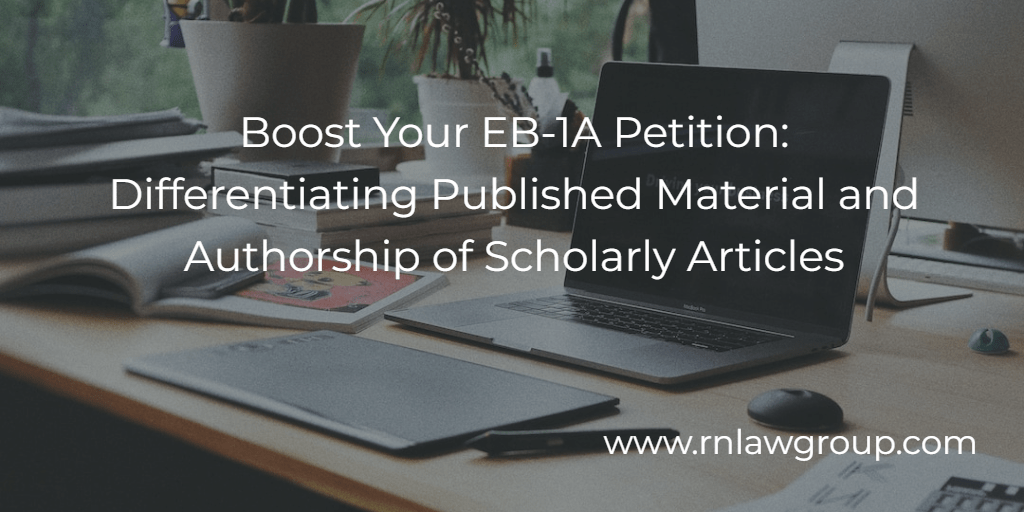
Boost Your EB-1A Petition: Differentiating Published Material and Authorship of Scholarly Articles
The EB-1A visa category is designed to attract individuals with extraordinary abilities in the arts, sciences, education, business, or athletics to the United States. An important element of an EB-1A petition is providing evidence of the applicant’s achievements and recognition in their respective field. In this context, two types of evidence are often presented: evidence of published material about the applicant and evidence of the applicant’s authorship of scholarly articles. While both types of evidence are important and seem relatively similar, it is crucial to understand the distinctions between them to construct a strong and compelling EB-1A petition.
- Evidence of Published Material About You:
Evidence of published material about the applicant refers to the documentation of articles, books, reports, interviews or any other media content where the applicant is the subject or is mentioned prominently. This evidence demonstrates that the applicant’s work and expertise have been recognized and publicized by professional or major trade publications or other significant media outlets.
Key elements of evidence of published material about the applicant include:
- Publication in professional or major trade publications: These are publications that are well-regarded and respected within the applicant’s field of expertise.
- Examples include journals, magazines, newspapers, or online platforms that focus on a specific industry or profession.
- Prominence of the applicant’s involvement: The evidence should highlight the extent of the applicant’s involvement in the published material. This could range from being the main subject of the article to being quoted extensively or referenced as a recognized authority.
- Relevance to the field: The published material should be related to the applicant’s area of expertise, demonstrating their impact and contributions within their field.
- Evidence of Authorship of Scholarly Articles:
Evidence of the applicant’s authorship of scholarly articles refers to the documentation that establishes the applicant as the author of academic papers, research articles, or similar scholarly works. This evidence showcases the applicant’s ability to contribute original and significant research to their field of expertise.
Key elements of evidence of authorship of scholarly articles include:
- Publication in professional or major trade publications: Similar to evidence of published material, the scholarly articles should be published in recognized academic or professional journals, which are respected within the applicant’s field.
- Quality and impact of the articles: The evidence should demonstrate the significance of the applicant’s scholarly work, such as citations, references, or acknowledgments from other experts in the field. The impact factor of the publication or the journal’s reputation may also be considered.
Differentiating Between the Two:
While evidence of published material about the applicant and evidence of authorship of scholarly articles share similarities, it is important to recognize their distinctions. These differences lie primarily in the nature, purpose, and audience of the publications:
- Nature and Purpose: Evidence of published material about the applicant typically includes articles, interviews, or reports where the applicant is the subject or is prominently featured. This type of evidence highlights the applicant’s recognition and reputation in the industry or profession. On the other hand, evidence of authorship of scholarly articles emphasizes the applicant’s original research, analysis, and contributions to their academic field.
- Audience: Evidence of published material about the applicant is often found in professional or major trade publications, which target a broader audience within a specific industry. These publications serve as a platform for sharing knowledge and industry-related information. In contrast, evidence of authorship of scholarly articles is typically found in academic or professional journals, which cater to a specialized audience of researchers, scholars, and experts in a specific field.
Conclusion:
Understanding the difference between proof of published material about the applicant and proof of authorship of scholarly papers is essential when creating an EB-1A petition. Both kinds of proof are important for demonstrating the applicant’s accomplishments and standing in their area of expertise. Applicants can strengthen their case and show their unique abilities by supplying a convincing selection of published materials and research publications, improving their chances of a successful EB-1A petition.
If you believe that you may qualify for the EB-1A visa category you should schedule an evaluation with an experienced immigration attorney!
Reddy & Neumann has been serving the business community for over 20 years and is Houston’s largest immigration law firm focused solely on US. Employment-based immigration. We work with both employers and their employees, helping them navigate the immigration process quickly and cost-effectively.
By: Staff Attorney
